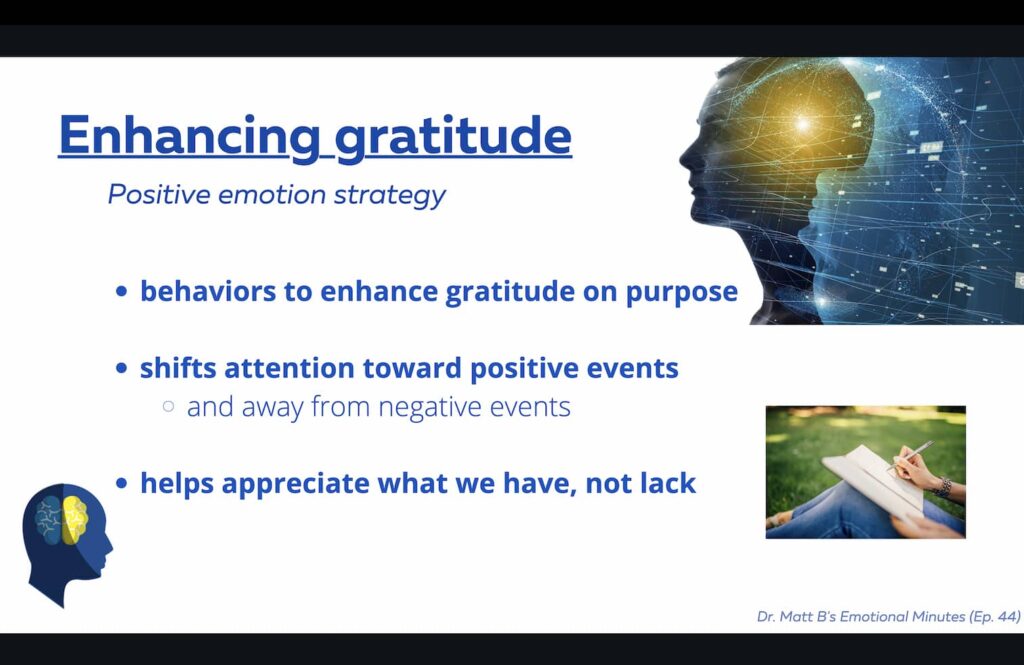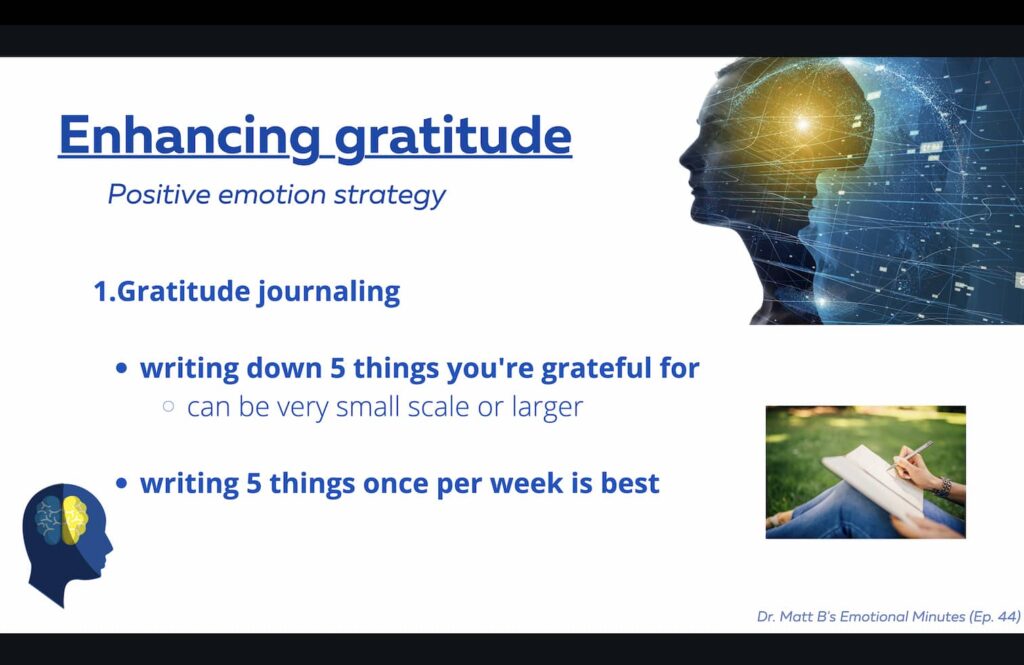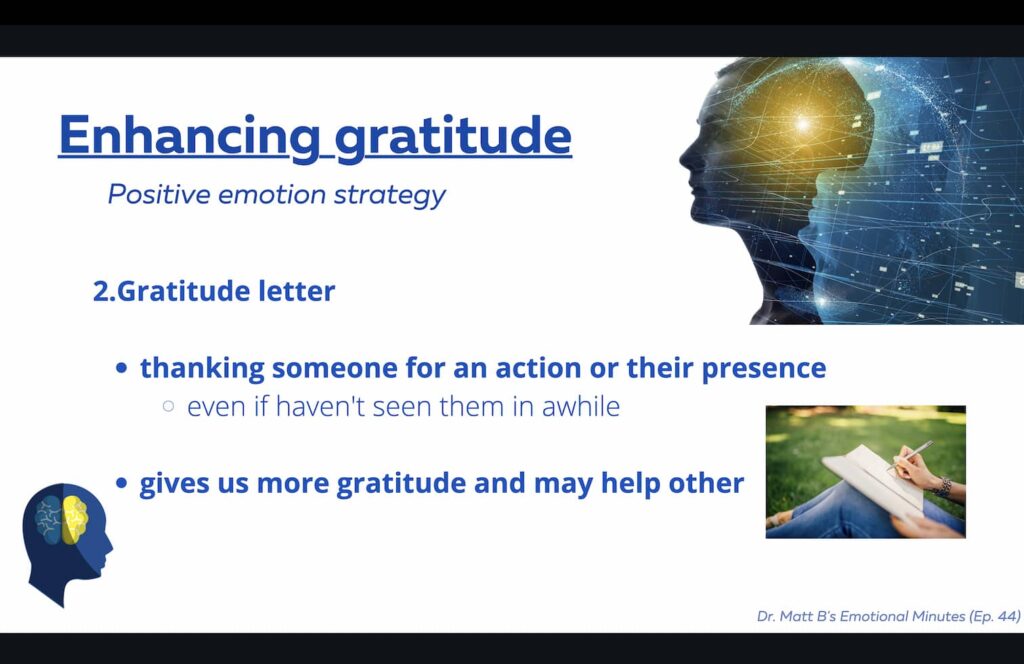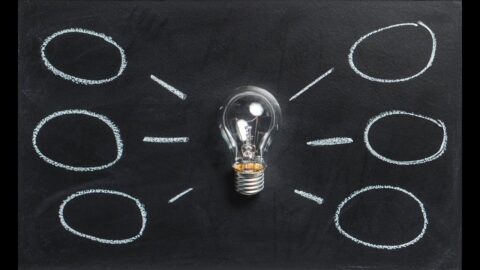How do I feel more gratitude? This video below describes how. Like other positive emotions, humans can’t just tell ourselves to feel more gratitude, and then it happens. But there are intentional behaviors we can use to increase gratitude.
Gratitude journaling and gratitude letters can help people experience more gratitude. Increased gratitude helps focus our attention away from negative experiences and on to more positive experiences. It also helps us focus on what we have in our lives, as opposed to what we lack.
Recent research also finds that increasing gratitude and other positive emotion strategies help prevent things like anxiety and depression. If you are interested, this good book describes more on the science of gratitude and other ways to see its benefits in your own life.
I’m Dr. Matt B., and these are your Emotional Minutes. I am at one of my favorite coffee shops. I came here today to do some gratitude enhancement. What we mean by gratitude enhancement is in line with these positive emotion strategies we’ve discussed. They are ways that you can increase your gratitude for things that you’ve experienced or for others, even if it’s people from your distant past. We are going to talk about some of these strategies today.
Gratitude Enhancement
What gratitude enhancement can do is enhance, like it sounds, behaviors that promote a sense of gratitude in us. We can’t just tell ourselves to feel more grateful. But, in going through the motions of these behaviors, we actually end up feeling more grateful. Gratitude can do what many of these positive emotion strategies we’ve been talking about do. They can focus our attention away from the negative aspects of life. This can be especially helpful when we find ourselves in a negative headspace because it directs our attention toward the positive aspects of our lives, especially gratitude.
One of the ways to think about it is that it leads us to appreciate what we have and the good things in our lives instead of focusing on what we lack. With gratitude enhancement, both gratitude journaling and gratitude letters, it doesn’t have to be big things that we’re focused on. They can be small things. Even being grateful for sunny weather that might happen on a specific day or somebody who held the door open for you.

Gratitude Journal
Today, we’ll talk about different strategies to enhance gratitude. The first strategy we look at when we look at gratitude enhancement is what we call gratitude journaling. I have previously discussed this in my episode on gratitude. Gratitude journaling is exactly what it sounds like. Research has found that there is a particular way to go about doing gratitude journaling to get the maximum positive effects. This method is listing or writing five things down that you’re grateful for.
You might think, “let me do this every day,” or “the more, the merrier.” However, interestingly enough, research has found that gratitude journaling is most effective if you do it a little bit more spread out, like once or twice a week, but gratitude journaling on several things you’re grateful for. Again, these can be small-scale things—for instance, a compliment from a friend or something somebody said at work or sunny weather. Today’s a beautiful day, so I’ll probably put this on the gratitude journal for this week. They can be larger-scale things or about people if any of those arise in your life within a particular week.

What this does is help you start to focus. This is one of those things you can see an immediate effect on. In the long term, it enables you to focus on things you do have in your life instead of what you lack. This gives you a good feeling even. I, at least, notice immediately after doing so that I start to feel more positive. I also started to focus more on the positive aspects of life. Research has found similar effects to that.
How to Start a Gratitude Journal
People do gratitude journaling differently. You can write it down in a journal if you like or use a spreadsheet as I do. When I do it, I just put the date and some things I am grateful for. I usually do it about once a week, but you could do it twice a week if you want. However, it is better to spread it out instead of logging one thing daily, for example.
Another reason I’m at this coffee shop in the video is that I’m trying to gratitude journal more. Anytime you create a new habit, it can help to pair it with an old one. I come to this coffee shop a fair amount, and it’s an enjoyable place for me, so it’s going to increase the chances of doing the gratitude journal more while I am here.
Gratitude Letters
The second gratitude enhancement strategy is what we call a gratitude letter. This is also what it sounds like, and I’ve talked about this on Emotional Minutes as a way to boost positive emotions and counter the effects of negative emotions. A gratitude letter is writing a letter to someone who has positively impacted you. Now, this could be something as simple as something small a co-worker did for you or someone who helped you with a problem. You might write them a letter saying thank you and describing the effect it had on you or how it was helpful. Or you might write something to someone, maybe a family member, who you appreciate.
For some people, this can be tough because sometimes people feel like they don’t have many individuals in their life. So one of the things that can be done is to send gratitude letters to people you haven’t talked to in years. Maybe it was a teacher back in school who positively affected you, a coach, or some adult you felt appreciated by them, or they did something you appreciated. These letters can do what we’ve been talking about: They focus your attention on enjoyable, positive, and good things you’ve had in your life and pull your attention away from what you feel you don’t have.

How to Make Gratitude Letters
When I do these, I like to use a lovely blank card like these snazzy sailing cards. Pick cards that you enjoy. In the letter, you can describe their effect on you, how they made you feel, or the benefit they had. One of the things that can help your gratitude enhancement is describing the event in some detail. For example, you can write, “Hey, you may not remember this, but this is the thing you did for me that I appreciate.”
One of the things about gratitude letters is that we may think it is going to make the other person feel good, and it really might, which is a nice effect you often see. However, sometimes you might not hear back from the individual. This is not about the impact on the other person because we can’t control other people’s emotions or behaviors. These gratitude enhancement strategies, especially gratitude letters, give good feelings to the person writing the letter regardless of what the person who receives the letter feels.
Hopefully, talking about gratitude enhancement was helpful today. The strategies I described were gratitude journaling and gratitude letters. These can be used as ways to boost our sense of gratitude and experience more positive emotions and thoughts. Gratitude enhancement can help you have a more positive, open, and creative headspace.
I’m Dr. Matt B., and these are your Emotional Minutes. We’ll see you next time.



